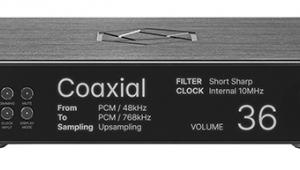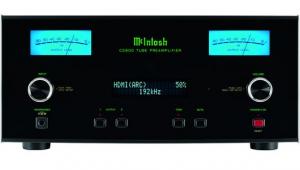Auralic Sirius G2.1/Vega G2.1 Upsampler/DAC Lab Report AURALIC SIRIUS G2.1
This Auralic pairing warrants two separate Lab Reports, not just because we have 'two boxes' in for review but because the very flexible resampling options offered by the Sirius G2.1 have the potential to alter the 'analogue' performance of the Vega G2.1 and, presumably, any other partnering DAC. Choosing to resample an LPCM digital input to an LPCM output of 48kHz-384kHz has no impact, say, on response (unless you are downsampling from 96kHz+ to 48kHz, etc) but it does cause a slight change in peak output level from 4.55V to 4.65V from low to high sample rates. Choosing a format conversion from LPCM to DSD via the Sirius G2.1 results in a far greater 0.7dB reduction in analogue output, and 0.6dB loss in S/N ratio, from the Vega G2.1 – potentially sufficient to skew a critical A/B comparison.
Distortion, too, changes whether an LPCM or DSD bitstream is fed into the Vega G2.1. At high levels (–5dBFs to 0dBFs) THD is a uniformly moderate 0.0012%/1kHz, regardless of sample rate or format, but at –10dBFs (a 'busy' area for much digital media) it falls to a significantly lower 0.00003% via a DSD64-DSD512 bitstream. Jitter also reveals differences in the LCPM and DSD resampling – this time in 'favour' of the former which achieves a vanishingly low 14psec versus 55psec (largely PSU-induced jitter) for the same 48kHz/24-bit data in DSD64-512 guise [see Graph].
In common with the earlier Altair G2.1 [HFN Oct '21], both the Sirius and Vega G2.1 offer four alternative digital filters – Precise, Dynamic, Balance and Smooth. These are duplicated but not 'doubled up' if the Sirius and Vega are used in combination. The Dynamic and Precise filters are linear phase/apodising types offering between 122-124dB of stopband rejection, but the 'Precise' offers the flattest and most extended response, reaching out to –3dB/45kHz and 90kHz with 96kHz/192kHz media versus –3dB/36kHz and 64kHz for the Dynamic filter.
The Balance and Smooth options offer a reduced 14dB and 18dB stopband rejection, with far gentler HF roll-offs amounting to –3.4dB and –4.2dB/20kHz, respectively, with CD and 48kHz files. With higher-rate files these filters reach just –3dB/28kHz and –3dB/47kHz (96kHz and 192kHz media). However, while their magnitude responses are similar, their time domain behaviour is very different – Balance is a low-order linear phase filter while Smooth is a low-order minimum phase/hybrid type with almost no acausal pre-ringing but a non-linear group delay. The respective time (impulse) and frequency responses with 48kHz media (solid traces), 96kHz (dotted) and 192kHz (dashed) are colour-coded in black and red for Precise and Smooth filter options. The test table [below] refers to the Sirius and Vega G2.1 in combination. PM

| Output level (48kHz/384kHz/DSD64/512) | 4.55V / 4.65V / 4.19V / 4.19V |
| A-wtd S/N (48kHz-384kHz/DSD64-512) | 116.1dB / 115.5dB |
| Distortion (1kHz, 0dBFs/–10dBFs; DSD512) | 0.0011% / 0.00003% |
| Distortion (20kHz, 0dBFs/–10dBFs; DSD512) | 0.005% / 0.00015% |
| Freq. resp. (20kHz/45kHz/90kHz; 384kHz) | +0.0 to –0.2dB/–3.8dB/–5.2dB |
| Digital jitter (48kHz-384kHz/DSD64-512) | 14psec / 62psec |
| Resolution (re. –100dBFs / –110dBFs) | ±0.1dB / ±0.4dB |
| Power consumption (Sirius G2.1) | 16W (14W standby) |
| Dimensions (WHD) / Weight | 340x96x320mm / 9.5kg |


















































